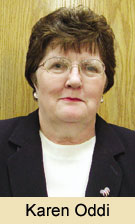2005 Evangelization Supplement
Vatican II expanded Church’s understanding of evangelization
By Karen Oddi
Archdiocesan evangelization coordinator
A few months ago, I heard from a nationally respected writer and catechetical leader what I thought was a very nice compliment for our archdiocese.
To paraphrase his words, Catholics in the Archdiocese of Indianapolis are not frightened or turned off by the word “evangelization” the way some audiences in other parts of the country appear to be.
 His comment gave me pause to wonder about what kinds of activities might be called evangelization in central and southern Indiana before Pope Paul VI in 1975 formally named it in his apostolic exhortation, “Evangelization in the Modern World” and before Pope John Paul II, in 1983, called for a new evangelization, thereby charting our path for present day evangelization efforts.
His comment gave me pause to wonder about what kinds of activities might be called evangelization in central and southern Indiana before Pope Paul VI in 1975 formally named it in his apostolic exhortation, “Evangelization in the Modern World” and before Pope John Paul II, in 1983, called for a new evangelization, thereby charting our path for present day evangelization efforts.
For a partial answer, I turned to Father John Sciarra, a friend and former pastor, who was ordained for the archdiocese in February 1945. Father Sciarra told me about a program of “street preaching” instituted by the late Archbishop Paul C. Schulte upon his appointment as archbishop of Indianapolis in 1946.
Father Sciarra said that street preaching involved pairs of young priests “going into towns where priests had never gone” and instructing residents in the teachings of the Catholic faith.
One priest would give a very short talk on a Catholic tradition or practice such as the rosary. Then the other priest would deliver a much longer sermon while the first priest moved about the audience collecting questions from the people for the priests to answer.
The whole exercise lasted about an hour. Father Sciarra especially recalls the towns of Greens Fork in Wayne County and Oolitic in Lawrence County as two of his street-preaching sites and the late Father Anthony Spicuzza as one of his preaching partners.
I asked Father Sciarra if the street preaching had ever been called “evangelization.” While the word evangelization was never used to describe the program, he agreed that it certainly would have been an accurate one.
According to Cardinal Avery Dulles, evangelization before Vatican Council II was indeed an effort of preaching; he calls it the kerygmatic model. Under Pope Paul VI, the model of evangelization became much more “inclusive” and was expanded even further by Pope John Paul II to involve all Catholics in a three-fold effort of passionately knowing one’s faith, inviting others to faith, and acting out of faith and knowledge to bring the Gospel of Jesus Christ into every human situation.
This threefold approach to evangelization is rooted in the accomplishments and documents of the Second Vatican Council that gave each baptized person both the right and the obligation to evangelize. Vatican II gave us, the People of God:
• the Rite of Christian Initiation of Adults that welcomes thousands of newcomers every Easter into the Catholic Church
• Catholic Bible study and the countless sharing and study programs
• the capacity as a Church to listen and learn from science, speak to the culture of the times and bring the Gospel of Life to social and political life
• the responsibility for every baptized person to live out the meaning of discipleship in what we call “shared responsibility” for the well-being of the faith community
• the confidence to pray with other Christians and to enter into respectful dialogue with other faith traditions
• the encouragement to express our Catholic beliefs in every aspect of family, work and social life.
Vatican II gave us a truly living legacy for the mission of evangelization in the Church and world of the
21st century.
On June 12, as we celebrate together the gift of the Eucharist and recommit ourselves to the new evangelization, let us remember those who have gone before us as evangelizers—and thank them for preparing our way. †
 His comment gave me pause to wonder about what kinds of activities might be called evangelization in central and southern Indiana before Pope Paul VI in 1975 formally named it in his apostolic exhortation, “Evangelization in the Modern World” and before Pope John Paul II, in 1983, called for a new evangelization, thereby charting our path for present day evangelization efforts.
His comment gave me pause to wonder about what kinds of activities might be called evangelization in central and southern Indiana before Pope Paul VI in 1975 formally named it in his apostolic exhortation, “Evangelization in the Modern World” and before Pope John Paul II, in 1983, called for a new evangelization, thereby charting our path for present day evangelization efforts.